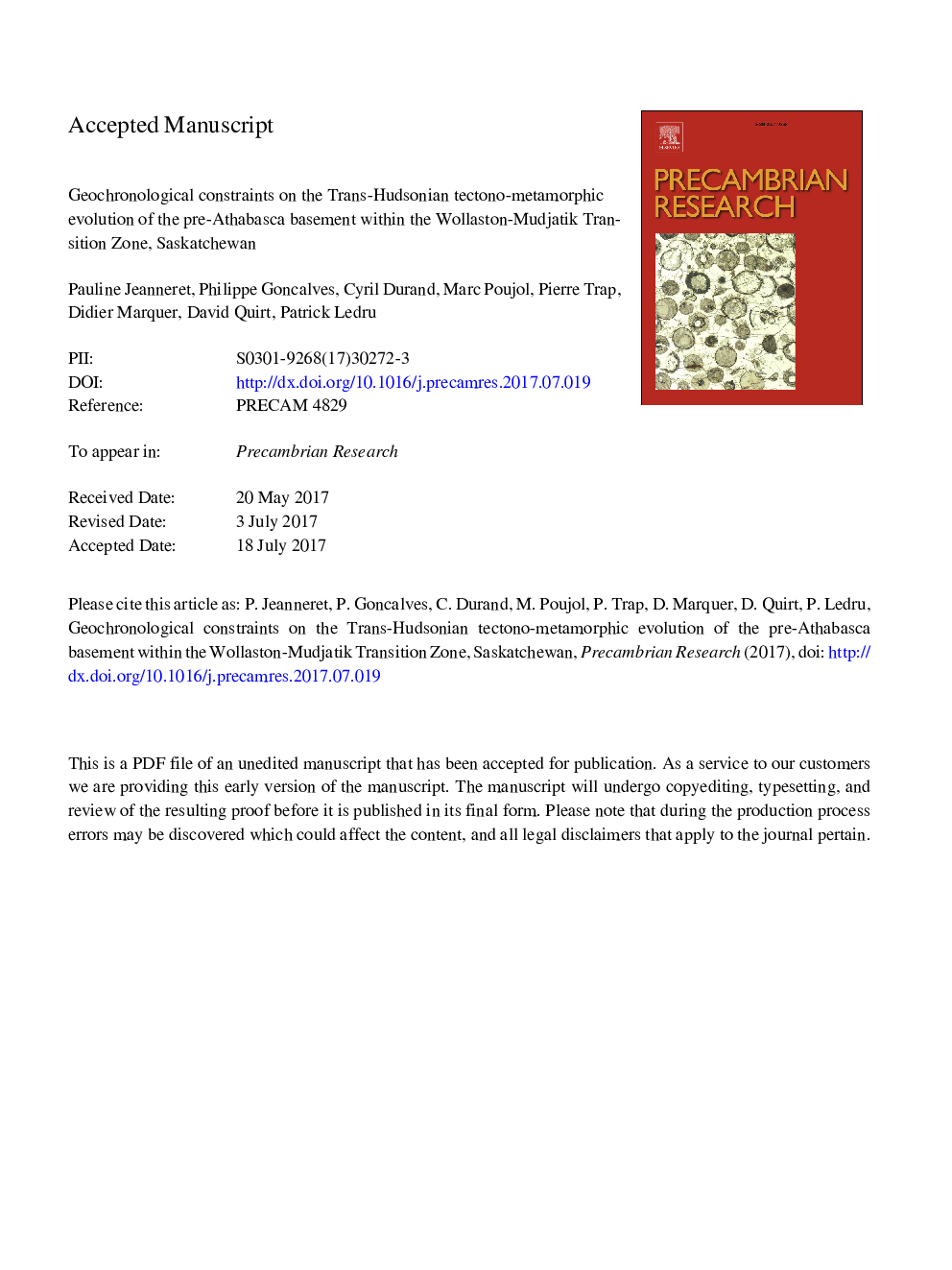| کد مقاله | کد نشریه | سال انتشار | مقاله انگلیسی | نسخه تمام متن |
|---|---|---|---|---|
| 5784672 | 1639574 | 2017 | 80 صفحه PDF | دانلود رایگان |
عنوان انگلیسی مقاله ISI
Geochronological constraints on the trans-Hudsonian tectono-metamorphic evolution of the pre-Athabasca basement within the Wollaston-Mudjatik Transition Zone, Saskatchewan
دانلود مقاله + سفارش ترجمه
دانلود مقاله ISI انگلیسی
رایگان برای ایرانیان
کلمات کلیدی
موضوعات مرتبط
مهندسی و علوم پایه
علوم زمین و سیارات
ژئوشیمی و پترولوژی
پیش نمایش صفحه اول مقاله

چکیده انگلیسی
The Hudsonian Pressure-Temperature-Deformation-time-(P-T-D-t) evolution of the pre-Athabasca crystalline basement (>â¼1700 Ma) of the Wollaston-Mudjatik Transition Zone (WMTZ) highlights two major tectono-metamorphic events M1-D1 and M2-D2. The ages of these two event have been obtained by in-situ LA-ICPMS U-Th-Pb dating of monazite from Grt-Crd bearing pelitic gneiss and U-Pb analyses performed on zircons from pegmatites, using both exposed basement and drill cores from the Wolly-McClean exploration drilling project. The M1-D1 event, interpreted as the burial of the thinned Hearne margin via southward thrusting to pressures varying from 10 to 6 kbar, occurred between ca.1840 and 1813 Ma. The M2-D2 event, producing the northeast structural trend of the WMTZ, was formed in a sinistral transpressional tectonic regime during the late stage of the Hudsonian oblique collision between ca. 1813 and 1770 Ma. Thermobarometric estimates on the M2-D2 assemblages show that the entire studied area was reequilibrated at about 5 kbar and 750-825 °C. trans-Hudsonian pegmatites are viewed as the main proto-ore of the uranium-rich Athabasca unconformity-type deposits. Formation, transfer and differentiation of these trans-Hudsonian pegmatites are replaced in this P-T-D-t evolution. During the 1840-1813 Ma M1-D1 partial melting event, the first batches of melt produced in the deep crust are the most likely enriched in uranium. Then, these melts were transferred upwards to the upper crustal levels owing to the development of crustal scale steeply-dipping D2 shear zones, and finally were differentiated to form uranium-enriched pegmatites between 1813 and 1770 Ma. Some monazite and zircon grains within retrogressed migmatites recorded a later event at ca. 1720 Ma, interpreted as the terminal cooling event down to 300-400 °C responsible for partial retrogression of metamorphic assemblages. This age provides new insights into the timing of the onset of the Athabasca sedimentation that should therefore be at least 1710 Ma old or younger.
ناشر
Database: Elsevier - ScienceDirect (ساینس دایرکت)
Journal: Precambrian Research - Volume 301, October 2017, Pages 152-178
Journal: Precambrian Research - Volume 301, October 2017, Pages 152-178
نویسندگان
Pauline Jeanneret, Philippe Goncalves, Cyril Durand, Marc Poujol, Pierre Trap, Didier Marquer, David Quirt, Patrick Ledru,